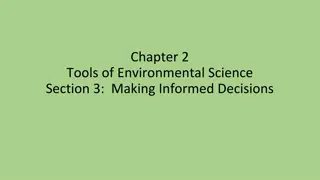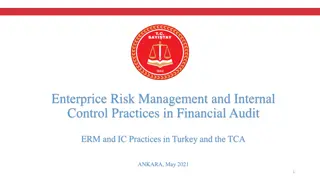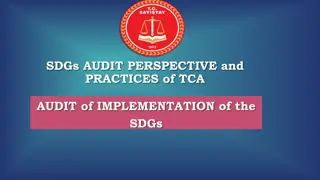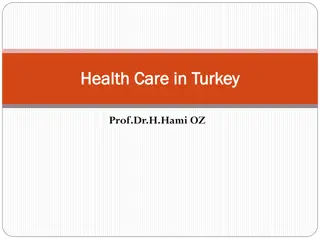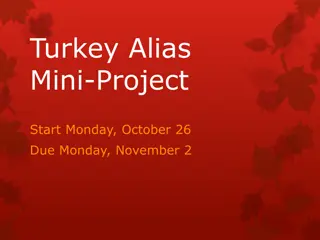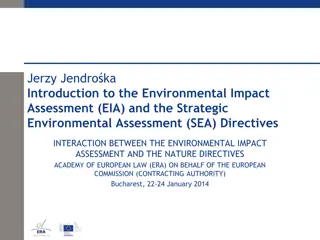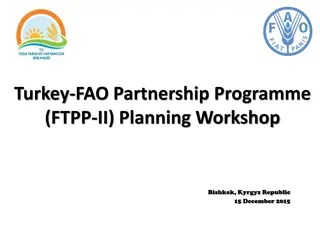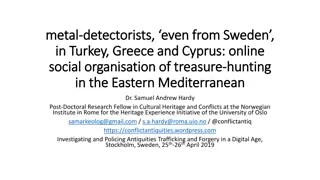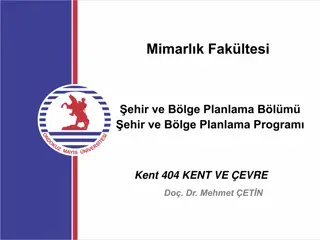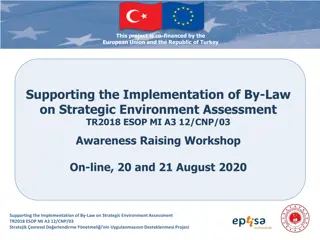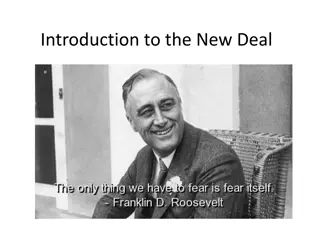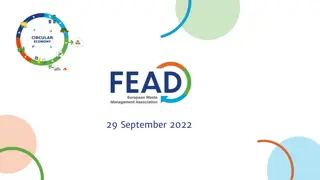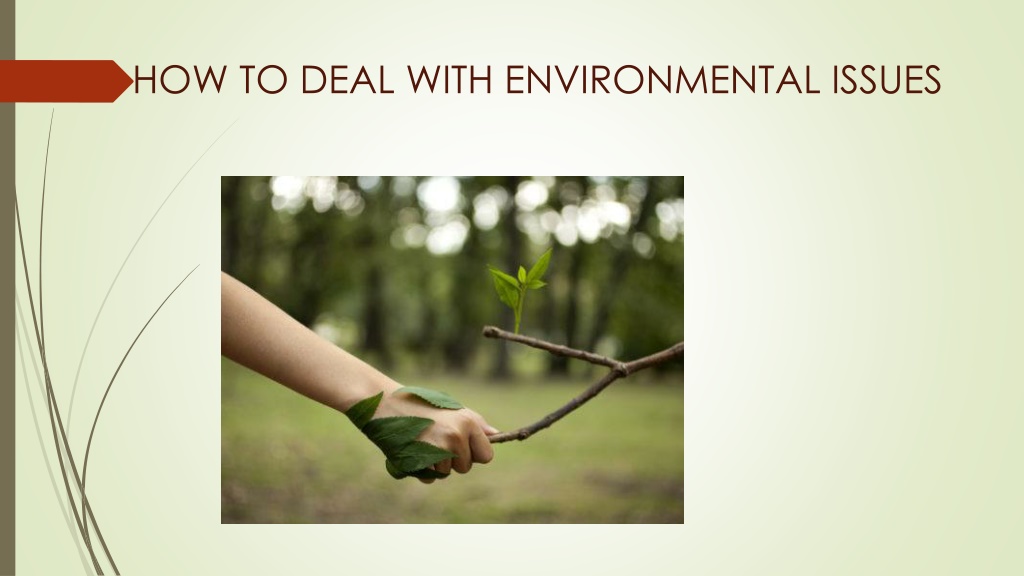
Effective Solutions for Environmental Challenges
Discover practical ways to address environmental issues such as loss of biodiversity, human-wildlife conflict, and ocean noise pollution. Learn how habitat restoration, conservation legislation, coexistence strategies, and sustainable practices can make a positive impact on the planet.
Download Presentation

Please find below an Image/Link to download the presentation.
The content on the website is provided AS IS for your information and personal use only. It may not be sold, licensed, or shared on other websites without obtaining consent from the author. Download presentation by click this link. If you encounter any issues during the download, it is possible that the publisher has removed the file from their server.
E N D
Presentation Transcript
1. Loss of biodiversity In 2019, the United Nations published a groundbreaking report stating that more than one million animal and plant species are at risk of becoming extinct in the upcoming decades. Conservationists have been urging us to protect wildlife for years, and now it s a race against the clock. The world needs biodiversity. Birds transport seeds across rainforests, sharks balance ocean food webs, mangroves hold important nutrients in wetlands without diverse species and their unique ecological roles, our planet would suffer greatly. What you can do: Habitat loss and fragmentation is one of the fastest growing threats against species survival. From shrinking elephant corridors in India to bulldozed koala eucalyptus groves in Australia, animals are losing their habitats at a startling rate. Help make a difference by respecting natural landscapes and participating in habitat restoration projects. Like all environmental issues, we also need large scale government action to help save endangered species. Support international and local wildlife protection legislation like the Endangered Species Act, and vote for candidates who advocate for conservation.
2. Human-wildlife conflict Today s human-dominated landscapes can make it difficult for animals to find abundant habitat and resources. Conflict real or perceived between people and wildlife looks different all around the world. For people in Malawi, conflict may include unexpected encounters with large animals like leopards, crocodiles, and hippos that cause serious injury - sometimes leading to retaliatory killing of wildlife. In India, community members face conflict with elephants who graze on crops and cause great economic loss. Across Canada and the United States, government programs kill thousands of wolves, beavers, bobcats, and bears through unscientific poisoning and cull initiatives. Throughout the COVID-19 pandemic, closed cities and quieter communities led to more accounts of wildlife sightings as animals came out of hiding. In this ever-changing world, it s important that we understand the role of wildlife and learn how to respect all species so we can better coexist. What you can do: Human wellbeing and wildlife protection are interconnected. When animals are treated with respect and able to play their natural role in the environment, humans benefit greatly. Ecosystems heal, lifestyles improve, eco-tourism thrives, and we get to appreciate the intrinsic beauty of wildlife. In urban areas and neighborhoods, approaches to human-wildlife coexist can be as simple as using animal-proof trash cans and walking pets on leashes. In rural areas, sustainable measures may include installing fencing around crops, training wildlife rangers, and securing wildlife corridors where animals can safely migrate without human encounters. Coexistence is possible and there are countless innovative solutions that promote the wellbeing of animals and humans.
3. Ocean noise and vessel strikes These days, most of us can order an item online with the click of a button but what comes as a convenience to us is a danger to wildlife. The majority of the world s products are transported by large cargo ships, and unfortunately, they are threatening the lives of marine animals. Ships and other industrial activity produce sound waves known as ocean noise pollution that create a maze of noise and disorient marine animals. Ocean noise pollution can prevent animals like dolphins and whales from communicating, hunting, and finding mates. In some cases, it can even lead to immense stress and death. Another issue facing marine animals is ship strikes and collisions of all sizes. Blunt trauma from propeller strikes and ship collisions can cause internal injury, sliced fluke tails, and a slow death for whales. For the case of the North Atlantic right whale, ship strikes are pushing the species to extinction. What you can do: Local consumerism is key to minimizing ocean noise and reliance on ships. Instead of purchasing items online which require shipping and plastic packaging, shop at local stores. If you do have to make an online purchase, skip the fast shipment option and choose consolidated packaging if you have more than one item. Reducing ship speeds is also a critical act for protecting marine mammals from ocean noise pollution and ship strikes. When ships operate at slower speeds, ocean noise reduces and the chance of vessel strikes drops drastically.
4. Plastic pollution An estimated eight million tons of plastic end up in our oceans every year, threatening the health of ecosystems, marine animals, and humans. Plastic debris can entangle marine animals, causing deep lacerations, starvation, and strangulation. Turtles are known to consume floating plastic bags (mistaking them for jellyfish) and 90% of all seabirds have consumed plastic. When plastics break down into microplastics, they are even more dangerous. Species lower on the food chain like fish, plankton, and oysters consume microplastics when filtering water. Toxins from the microplastics then get passed through the food web, reaching their way to large marine animals and humans. What you can do: Choose a day to track all of the disposable plastic that you use from morning to night. After you ve written a list, research and choose sustainable alternatives made out of material like wood, glass, or natural fibers. Replacement items could include reusable produce bags for bulk shop to keep in your car, or reusable snack baggies - the list is endless. For times when you do purchase plastic, always recycle and do it correctly. Make sure you wash containers before throwing them in the bin and familiarize yourself with local recycling protocols. ping, travel utensils
5. Intensive farming of animals Intensive farming also known as factory farming involves industrialized facilities utilizing confinement systems with high stocking densities. Not only does intensive farming cause immense suffering to millions of animals, but it also has a devastating environmental impact. 37% of the world's methane emissions come from factory farming. Untreated animal waste full of highly concentrated chemicals and bacteria is stored in giant manure lagoons that emit gases like carbon dioxide, methane, and ammonia. When overflow occurs from broken infrastructure or rain, the waste leaches into soil and causes dangerous threats to environmental and human health. This includes harmful algae blooms, contamination of drinking water, ammonia pollution, and pathogen outbreaks. What you can do: Reduce your meat consumption by incorporating more vegetarian and vegan meals into your diet. Use it as an opportunity to explore new plant-based ingredients and recipes. Buy local produce and support local farms where animal welfare and environmental impact are prioritized. Educate yourself on the meanings of certifications and labeling, and advocate for better protection for farmed animals through new legislation propositions.
6. Food waste Food waste and loss occurs along every step of food production, from farms to factories, to grocery stores and consumers. During production, waste happens when production exceeds demand, manufacturing damages product, and food spoils during transportation. On the consumer end, food waste occurs mainly from over- purchasing and throwing out blemished produce. The United States Department of Agriculture estimates that 30-40% of food in the United States goes to waste. All food has an ecological footprint. When we waste food, we waste the energy and natural resources that went into production, and contribute to landfills that produce greenhouse gases. What you can do: Vegetables don t need to be perfect. As long as the food isn't spoiled, blemishes and imperfections are safe to consume. Remember to take what you need and eat what you take. If you have a habit of over-purchasing food, try to actively buy less or donate to local food banks. Learn how to properly store and freeze food to make it last longer and save money. Consider starting a compost bin where leftover food scraps can turn into nutritious soil for your garden. Don t have a garden of your own? Donate your compost soil to a nearby farm, urban garden, or school.

